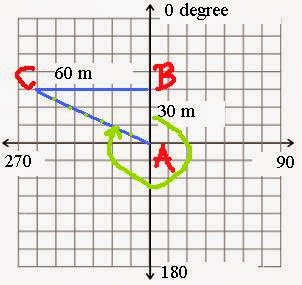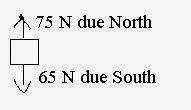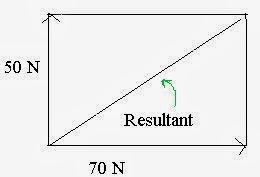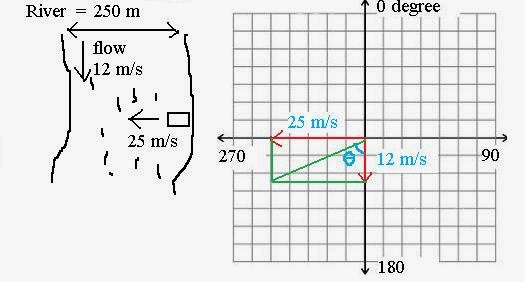Question: The 6000kg
787 airplane speed on the runway up to 85 m/s before takeoff. Determine the momentum of the airplane right before takeoff.
The equation of momentum is given by
p = m*v
- p, momentum in kg * m/s
- m, mass in kg
- v, velocity of the object in m/s
p = 6000 * 85 = 5.1 x 10^5 kg-m/s
Question: A space craft forces it engines in deep space, the engine exert a force of 9500 N for a period of 20 s. The mass of the spaceship is 3500kg. What is the change in velocity of the spaceship? What is the final speed?
Impulse is a force applied over a given amount of time, F * t
- F, force applied in Newton (N)
- t, time in seconds
Impulse is the change in momentum induced in an object,
F * t = m * delta V
- t = 20 s
- F = 9500 N
- m = 3500 kg
- Si, initial speed = 0
(9500) * (20) = (3500) * delta V, delta V = 54.28 m/s
The equation for final speed is give by Sf = Si + a*t
Find a by using Newton's Second Law, F = m*a
(9500 N) = (3500 kg) a, a = 2.714 m/s^2
Sf = 0 + (2.714 m/s^2)* 20 s, Sf = 54.28 m/s
Question: A 10,000 kg freight train car travelling at 10 m/s collide with a second freight train car of mass 9500 kg travelling 2 m/s. After collision the first car is travelling at 4 m/s. What is the velocity of the second car? (This is an example of an
elastic collision, which the object do not stick together after collision.)
The equation of conservation of momentum is given by
m1*v1 + m2*v2 = m1*v1' + m2*v2'
- the left side of the equation is the system before collision
- the right side of the equation is the system after collision
- m1, mass of first object
- m2, mass of second object
- v1, velocity of the first object before collision
- v2, velocity of the second object before collision
- v1', velocity of the first object after collision
- v2', velocity of the second object after collision
(10,000) (10) + (9500) (2) = (10000) (4) + (9500) (v2')
solve for v2', v2' = 8.32 m/s
Question: A car of mass 1500 kg travelling at 20 m/s collides with a second stationary car of mass 2000 kg. The car bumper lock after collision. What is the velocity of the wreckage immediately after impact? (This is an example of an inelastic collision, which the object stick together after collision).
m1*v1 + m2*v2 = m1*v1' + m2*v2'
After the collision, the mass is combined, and only one velocity
m1*v1 + m2*v2 = (m1 + m2) * V
1500 (20) + 2000 (0) = (1500 + 2000) V
solve for V, V = 8.57 m/s
Question: A bullet of mass 50 g and travelling at 450 m/s impact and embeds in a 50 kg wooden block suspended by a two sting as shown. a) What is the speed of the block and bullet immediately after collision? b) How much momentum is lost by the bullet? c) How high does the block rise above its initial rest position?
a) 50 g = .050 kg
m1*v1 + m2*v2 = (m1 + m2) * V
(.050) (450) + (5) (0) = ( .050 +5) V
22.5 (kg-m)/s = 5.05 kg V
4.46 m/s = V
b) delta P1 = 22.5 - .050 (4.46) = 22.3 (kg-m)/s lost by bullet
c) delta P2 = m*V = 5(4.46) = 22.3 (kg-m)/s gain by block
d) a = -9.8 m/s ^2, h= d, Si = 4.46 m/s
d = (Sf^2 - Si^2) / 2a = (0 - 4.46 ^2) / (2* -9.8) = 1.01 m
Question: A 500 kg cannon at rest fires a cannon ball of mas 2 kg. The velocity of the cannon ball is 200 m/s. a) What is the recoil velocity of the cannon ball? b) If the cannon is fired horizontally from the top of a tower 60 m tall, how far from the base of the tower does the cannon ball land? (This is an example of Newton's third law of motion, action= reaction).
a) Before After
m1*v1 + m2*v2 = m1*v1' + m2*v2'
(500)(0) + 2 (0) = 500 *v1' + 2 (200)
0 = 500 * v1' + 400
-.8 m/s = v1'
b) d = 1/2 * a * t^2
60 = 1/2 (9.8) t^2
3.5 s = t
dH = vH * t = (200 m/s) 3.5s = 700 m
Question: Identical twins Kate and Karen each have a mass of 45 kg. They are rowing their boat on a hot summer afternoon when they decide to go for a swim. Kate jumps off the front of the boat at a speed of 3.00 m/s. Karen jumps off the back at a speed of 4.00 m/s. If the 70.-kilogram rowboat is moving at 1.00 m/s when the girls jump, what is the speed of the rowboat after the girls jump?
Use conservation of momentum:
momentum before collision = momentum after collision
m1*v + m2*v + m3*v = m1*vb + m2*v1 + m3 *v2
( combine mass of boat and twins) * v = (70) * vb + (45)*3 + 45 * (-4),
the minus speed for Karen because she jump off to the left in the opposite direction of the moving boat
(70 + 45 + 45 kg) 1 m/s = 70 * vb + 135 + -180
160 = 70 * vb + -45
205 = 70 * vb
2.93 m/s = vb, boat moving to the right
Note: Check the answer by plug vb into the original equation.















